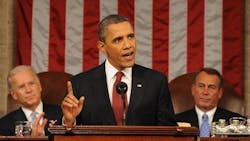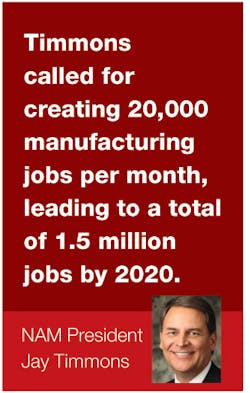The Global Manufacturer: Obama, NAM and the State of Manufacturing
"Our first priority is making America a magnet for new jobs and manufacturing," President Obama told the nation in his State of the Union address Feb. 12. There's nothing like a televised SOTU speech to showcase the disunion in the nation's capital. But judging from the applause (and we won't put too much faith in that) that manufacturing received in the speech, the industry is back on the radar of lawmakers and no longer relegated to economic irrelevance.
See Also: Global Manufacturing Economy Trends & Analysis
To illustrate his point, Obama visited Linamar Corp.'s plant in Asheville, N.C., the next day. Linamar, a Canadian manufacturer of auto components, assemblies and castings, took over an empty Volvo plant and now employs 160 people there.
That same day, NAM President Jay Timmons was in Detroit giving his "state of manufacturing" address and laying out his organization's plan for boosting manufacturing production and jobs.
TAXES: In his SOTU speech, Obama said now was the "best chance for bipartisan, comprehensive tax reform that encourages job creation and helps bring down the deficit." The president has said he supports lowering the tax rate for manufacturers to 25%, making the R&D tax credit permanent and putting in place a global minimum tax. The goal, he said, is to "stop rewarding businesses that ship jobs overseas" and "reward companies that are creating jobs" in the U.S.
In his Detroit address, Timmons said manufacturers need "competitive tax rates at the individual and corporate levels." He noted that the average corporate tax rate of U.S. trading partners was now 23% and called for the nation's leaders to propose a rate competitive with Canada's 15% tax rate. He said tax reform must recognize that two-thirds of manufacturers "pay taxes as individuals, through S-corporations."
JOBS: The president referenced the addition of 500,000 manufacturing jobs in the past three years and noted that companies such as Caterpillar (IW 500/21), Ford (IW 500/6), Intel (IW 500/26) and Apple (IW 500/9) were bringing jobs back to the U.S. He said the moves were being prompted by an outstanding workforce, lower energy costs and the biggest market in the world. But he cautioned that not all the jobs lost in manufacturing would be regained due to automation and other productivity enhancements.
Timmons called for creating 20,000 manufacturing jobs per month, leading to a total of 1.5 million jobs by 2020. But he warned that job growth comes from establishing a competitive business environment that includes the right tax, regulatory, energy, trade and education policies.
INNOVATION: Obama in his SOTU address pointed to the manufacturing innovation institute in Youngstown, Ohio, launched with money the administration cobbled together from existing budgets. The president is asking Congress for $1 billion to fund a total of 15 of these hubs.
NAM says it wants U.S. manufacturers to be "the world's leading innovators." Timmons called for providing "strong and reliable incentives" for R&D, noting that the R&D tax credit is "routinely authorized retroactively." He also urged measures to enhance protection for intellectual property and cybersecurity.
TRAINING: Obama proposed a goal of training 2 million Americans with the skills needed to lead them directly to a job. As an example of this process, he pointed to Linamar's work with AB-Tech, a local community college, to devise a customized training program that brought students into the plant to gain experience working on the machines and processes they would be running when hired.
Timmons said more than 600,000 jobs are going unfilled because of a skills gap. He said NAM is tackling the skills gap through longer-term efforts to improve STEM education, and more immediately by working with community colleges to create portable skills certification programs. He also called for comprehensive immigration reform, noting that "our broken immigration system sets up unnecessary barriers" to workers with advanced skills that want to work in the U.S.
My reading of the two speeches: there's substantial agreement on many of the specifics but that will remain a minor chord in the thunder over taxes and regulation.
About the Author
Steve Minter
Steve Minter, Executive Editor
Focus: Leadership, Global Economy, Energy
Call: 216-931-9281
Follow on Twitter: @SgMinterIW
An award-winning editor, Executive Editor Steve Minter covers leadership, global economic and trade issues and energy, tackling subject matter ranging from CEO profiles and leadership theories to economic trends and energy policy. As well, he supervises content development for editorial products including the magazine, IndustryWeek.com, research and information products, and conferences.
Before joining the IW staff, Steve was publisher and editorial director of Penton Media’s EHS Today, where he was instrumental in the development of the Champions of Safety and America’s Safest Companies recognition programs.
Steve received his B.A. in English from Oberlin College. He is married and has two adult children.

